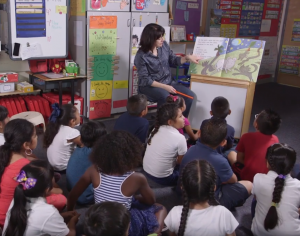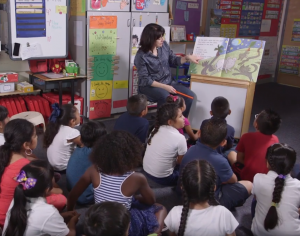What Is Shared Reading?
Shared Reading is an instructional approach used to support students to read, think, and discuss texts. It’s part of a broader balanced literacy framework where teachers support students to develop independence and meaning-making abilities through approaches like Read Aloud, Shared Reading, Guided Reading, and Independent Reading alongside the parallel writing approaches. As a joyful, collaborative learning activity, Shared Reading provides children “with an enjoyable reading experience, to introduce them to a variety of authors and illustrators and the ways these communicators craft meaning, and to entice them to want to be readers themselves” (Parkes, 2000).
In Shared Reading experiences, a single copy of the text is enlarged, such as with a big book or chart or projected by digital technology. This enables all students to look at and interact with the same text. Teachers use pointers or other tools (e.g. word and letter frames or wiki sticks) to draw attention to particular places in the text he or she knows are important for students to attend to in our demonstrations. While some people propose all children having an individual copy of a text during Shared Reading, the reality is, if all students have texts, they may not actually be attending to what it is the teacher is trying to illustrate within the shared reading lesson. While later on there may be times to give children copies of a text, or parts of a text, during the time when the group is working together, Shared Reading lessons using one enlarged copy are more focused.
Within Shared Reading, texts progress through a process of use, reappearing throughout the school year. The texts become more familiar with each reading, beginning with initial days to get to know the text, then reappearing later in subsequent learning sessions that deepen meaning and illustrate how skills and strategies work in context. Through revisits to known texts, children come to understand that texts say things in certain ways. With explicit teaching in Shared Reading, students are taught to intentionally notice how texts work at the text level, the sentence level, and the print level.
Shared Reading provides the kind of teaching that strengthens the syntactic system. This is the language system of reading. Children require the repetition of rich literature to develop an ear and tongue for the “syntactic patterns, idioms, and tunes of the language” ensuring “the patterns of book dialect are running through the automatic language system of the child” (Holdaway, 1979). Here, we mean not only vocabulary but also phrases, sentence structures, and rhythms and cadences of language found in written language. Through repetitive readings of known texts in Shared Reading, readers begin to anticipate what the next part of a text might be, the next word, the next phrase. This language system is foundational for all reading; without a strong language system, letters, sounds, and words have no meaning.
What Should Shared Reading Look Like?
A common misconception of Shared Reading is that all children join in on the first reading of the text. Children are expected to join in on the collaborative thinking as they read and think together on the first read. We have to remember that reading is what happens in the brain, not what happens with the voice. Children are invited to join the oral reading as they feel comfortable joining in and this occurs during different readings for different students. Some Shared Reading texts invite early participation, especially when there is rhyme, rhythm, and repetition of lines or sections of text. Other texts need more exposure before children feel comfortable joining in. Eventually, with multiple readings, the goal is that children do join in and become able to read the text for themselves. Click here to learn more about Okapi's Shared Reading program, Lift Off to Literacy™. Debra Crouch
See link for Independence plus Mean Making Diagram.


